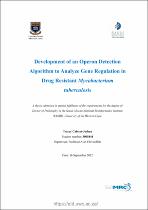| dc.contributor.advisor | Christoffels, Alan | |
| dc.contributor.author | Calvert-Joshua, Tracey | |
| dc.date.accessioned | 2023-05-22T08:55:20Z | |
| dc.date.available | 2023-05-22T08:55:20Z | |
| dc.date.issued | 2022 | |
| dc.identifier.uri | http://hdl.handle.net/11394/10035 | |
| dc.description | Doctor Educationis | en_US |
| dc.description.abstract | In prokaryotes, operon structures often form to allow microorganisms to respond rapidly and efficiently to changing environmental conditions. Operons are sets of neighbouring genes which are co-regulated and co-transcribed. Studies have shown evidence of operons changing their lengths and/or maintaining their lengths while up- or downregulating their expression levels when exposed to various stresses. Since several operons have also been associated with drug resistance, having access to the operon map of Mycobacterium tuberculosis (Mtb), may give us insight into the existing mechanisms employed by Mtb to circumvent drug stress, and more importantly, it may allow us to target larger sections of a genome when designing antitubercular drugs. | en_US |
| dc.language.iso | en | en_US |
| dc.publisher | University of the Western Cape | en_US |
| dc.subject | Mycobacterium tuberculosis | en_US |
| dc.subject | Bioinformatics | en_US |
| dc.subject | Coding | en_US |
| dc.subject | Chemistry | en_US |
| dc.title | Development of an operon detection algorithm to analyze gene regulation in drug resistant Mycobacterium tuberculosis | en_US |
| dc.rights.holder | University of the Western Cape | en_US |

